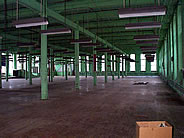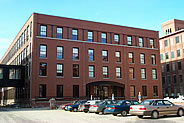Waste Site Cleanup & Reuse in New England
Former Civil War Textile Mill is Given New Economic Life with the Help of $775,000 in Funding from the EPA
Success in Assessment Demonstration Pilot
Program
Lewiston, ME
(December 3, 2003)
Contacts
The Bates of Maine Woolen Mill, a former industrial anchor for western Maine, was transformed into a modern and bustling economic hub following years of community and state involvement and extensive assistance from the US Environmental Protection Agency. Through a US EPA Brownfields Assessment grant of $200,000 in 1998, an additional $75,000 in supplemental funding in 2000, and a half million dollar Brownfields Revolving Loan Fund set up in 1999, the city of Lewiston was able to assess and remediate the huge 1.2 million square foot textile mill. The transformed complex will bring millions of dollars in new business investments to the community’s struggling economy.
With a history that dates back to the Civil War, the Bates Mill has been a focal point for industry in the great state of Maine. The plant, a textile manufacturer, that once helped outfit the legendary Grand Army of the Potomac, was once the largest single employer in the state. The mill maintained that status until the early 1960s when the domestic textile industry began to loose steam due to the pressure of foreign competition. By 1992, the majority of shop operations had ceased and only 50 workers operated in a small section of the massive 1.2 million square foot structure. Operations stopped altogether soon afterward leaving six acres and the dozen buildings the once comprised the mill vacant and potentially contaminated. The city of Lewiston gained ownership of the property and the Lewiston Mill Redevelopment Corporation, a nonprofit organization, now manages the enormous property.
The city was faced with a huge economic and environmental behemoth. Officials and members of the community wanted to preserve the existing structure due to its historic value, but they also wanted to assess and then remediate the generations of environmental contaminants that lurked within, under, and around the large site. The city enlisted the help of the EPA to fund the massive assessment and following cleanup effort and in 1998 received a $200,000 EPA Brownfields Assessment grant. The grant allowed them to hire an independent environmental contractor to assess what type and level of contamination was to be found at the site.
The Phase I and Phase II environmental assessments revealed levels of PAH’s, metals, PCBs, votile organic compounds, lead, asbestos, and petroleum products. As a result of the Phase I assessment, the EPA conducted a Superfund removal action in 1999 that focused on removing PCB contamination, asbestos, and leaking drums. The cost of this action was $387,000.
The EPA stepped in again in 1999, during the initial cleanup and awarded the city $500,000 to capitalize on a Brownfields Revolving Loan Fund for the cleanup of the entire mill.
Following the assessment and removal of hazardous wastes, the city began the long road to total remediation. The plan was to remediate the buildings from the inside-out in order to preserve as much of the existing historic value as possible and save on demolition and debris cleanup costs. As of 2001, approximately 284,000 square feet of the facility had been cleaned up and leased to private businesses. A branch of Banknorth, the parent company of People’s Heritage Bank, a portion of the University of Maine, as well a popular restaurant, telecommunications company, photography arts center, packaging company, and various other nonprofit organizations and businesses now occupy the portions of cleaned and contaminant free space in the mill complex. By 2003,1,400 new jobs had been created as a result of the preliminary redevelopment and the city’s economy was given a large boost with an additional $500,000 in annual tax revenue and over $17 million in additional private sector investment.
In 2003, the city granted the Lewiston Mills Redevelopment Corporation $150,000 of the initial loan to finish remediation on the remainder of the property. Summit Environmental Consultants will oversee the redevelopment and Environmental Projects Inc. based in Yarmouth, ME will preform the actual remediation.
Through the EPA funding, the city was able to leverage a total of $41 million from federal, state, and local sources, including $15 million in private investments. Through strong community involvement and strong economic and development planning, the finalized Bates Mill complex will help to revitalize the downtown area and bring back some of the economic prosperity that the blossoming textile mill once enjoyed.
The Bates Mill complex is expected to become the hub of economic redevelopment for the New England city. The finalized complex is expected to employ over 5,000 workers. Following completion of the complex, which is projected to house both fitness and a daycare center for employees, private businesses and a regional conference center, city officials will move on to other portions of the city that are in need of environmental and economic revival.
The city of Lewiston has a population of 29,000 people. Unemployment was at about 4.1% in 2000 according to the US census. Median household income for the city is $29,0000 per year and 10% of the population live below the poverty level.
| EPA Fact Sheets: | Assessment
Demostration Pilot |
| Assessment Demonstrate Pilot - Supplemental Funding |





